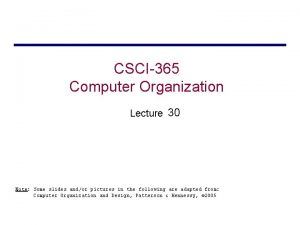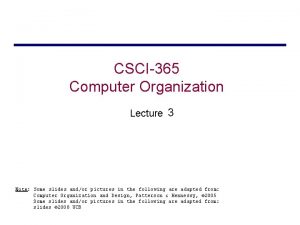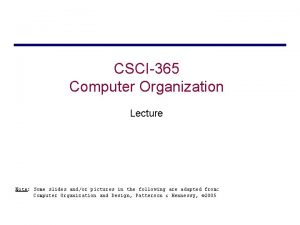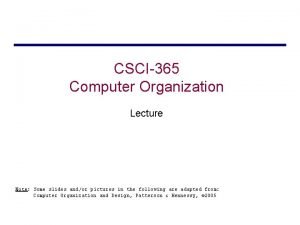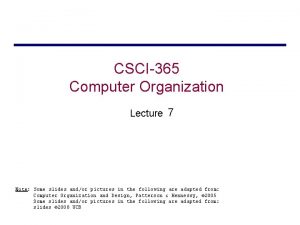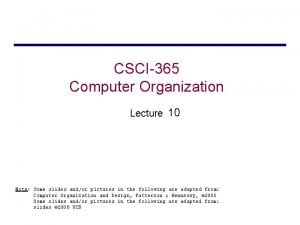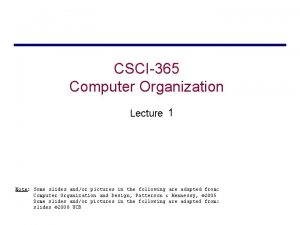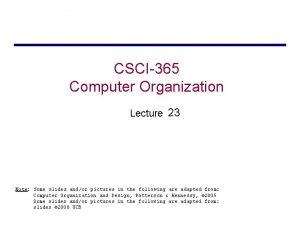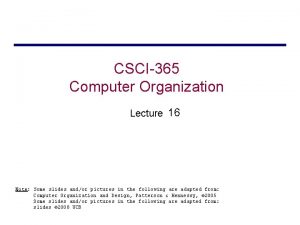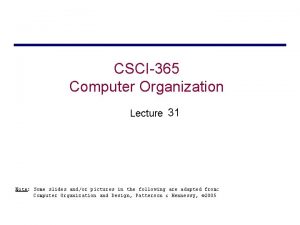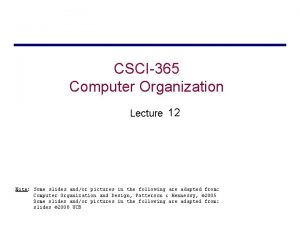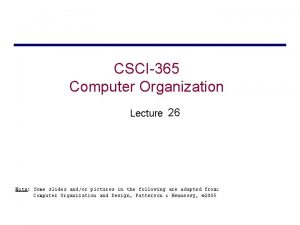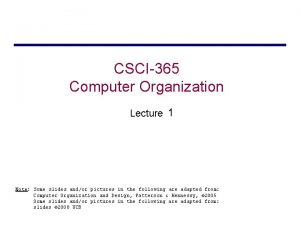CSCI365 Computer Organization Lecture 11 Note Some slides














- Slides: 14

CSCI-365 Computer Organization Lecture 11 Note: Some slides and/or pictures in the following are adapted from: Computer Organization and Design, Patterson & Hennessy, © 2005 Some slides and/or pictures in the following are adapted from: slides © 2008 UCB

Representation of Fractions “Binary Point” like decimal point signifies boundary between integer and fractional parts: Example 6 -bit representation: xx. yyyy 21 20 2 -1 2 -2 2 -3 2 -4 10. 10102 = 1 x 21 + 1 x 2 -3 = 2. 62510 If we assume “fixed binary point”, range of 6 -bit representations with this format: 0 to 3. 9375 (almost 4)

Fractional Powers of 2 i 2 -i 0 1 2 3 4 5 6 7 8 9 10 11 12 13 14 15 1. 0 1 0. 5 1/2 0. 25 1/4 0. 125 1/8 0. 0625 1/16 0. 03125 1/32 0. 015625 0. 0078125 0. 00390625 0. 001953125 0. 0009765625 0. 00048828125 0. 000244140625 0. 0001220703125 0. 00006103515625 0. 000030517578125

Representation of Fractions So far, in our examples we used a “fixed” binary point. What we really want is to “float” the binary point. Why? Floating binary point most effective use of our limited bits (and thus more accuracy in our number representation): example: put 0. 1640625 into binary. Represent as in 5 -bits choosing where to put the binary point. … 000000. 001010100000… Store these bits and keep track of the binary point 2 places to the left of the MSB Any other solution would lose accuracy! With floating point rep. , each numeral carries a exponent field recording the whereabouts of its binary point. The binary point can be outside the stored bits, so very large and small numbers can be represented.

Scientific Notation (in Decimal) significand 6. 0210 x 1023 decimal point exponent radix (base) • Normalized form: no leadings 0 s (exactly one digit to left of decimal point) • Alternatives to representing 1/1, 000, 000 – Normalized: 1. 0 x 10 -9 – Not normalized: 0. 1 x 10 -8, 10. 0 x 10 -10

Scientific Notation (in Binary) significand 1. 0 two x 2 -1 “binary point” exponent radix (base) • Computer arithmetic that supports it called floating point, because it represents numbers where the binary point is not fixed, as it is for integers – Declare such variable in C as float

Floating Point Representation • Normal format: +1. xxxxxtwo*2 yyyytwo • 32 -bit version (C “float”) 31 30 23 22 S Exponent 1 bit 8 bits S represents Sign Exponent represents y’s Significand represents x’s Significand 23 bits 0

Floating Point Representation • Normal format: +1. xxxxxtwo*2 yyyytwo • 32 -bit version (C “float”) 31 30 23 22 S Exponent 1 bit 8 bits Significand 0 23 bits • Positive and negative numbers closest to zero? (done in class) • Positive and negative numbers furthest from zero? (done in class)

Floating Point Representation • What if result too large? – Overflow! Exponent larger than represented in 8 -bit Exponent field • What if result too small? – Underflow! Negative exponent larger than represented in 8 -bit Exponent field underflow overflow -1 0 1 • What would help reduce chances of overflow and/or underflow?

Double Precision Fl. Pt. Representation • 64 bit version (C “double”) 31 30 20 19 S Exponent Significand 1 bit 11 bits 20 bits Significand (cont’d) 32 bits 0 • Double Precision (vs. Single Precision) – C variable declared as double – Positive and negative numbers closest to zero? (done in class) – Positive and negative numbers furthest from zero? (done in class) – But primary advantage is greater accuracy due to larger significand

QUAD Precision Fl. Pt. Representation • Next Multiple of Word Size (128 bits) – Unbelievable range of numbers – Unbelievable precision (accuracy) • Currently being worked on (IEEE 754 r) – Current version has 15 exponent bits and 112 significand bits (113 precision bits) • Oct-Precision? – Some have tried, no real traction so far • Half-Precision? – Yep, that’s for a short (16 bit) en. wikipedia. org/wiki/Quad_precision en. wikipedia. org/wiki/Half_precision

IEEE 754 Floating Point Standard Single Precision (DP similar): 31 30 23 22 S Exponent 1 bit 8 bits Significand 23 bits • Sign bit: 1 means negative, 0 means positive • Significand: – To pack more bits, leading 1 implicit for normalized numbers – 1 + 23 bits single, 1 + 52 bits double – always true: 0 < Significand < 1 (for normalized numbers) • Note: 0 has no leading 1, so reserve exponent value 0 just for number 0 0

IEEE 754 Floating Point Standard • IEEE 754 uses “biased exponent” representation – Designers wanted FP numbers to be used even if no FP hardware; e. g. , sort records with FP numbers using integer compares – Wanted bigger (integer) exponent field to represent bigger numbers – 2’s complement poses a problem (because negative numbers look bigger)

IEEE 754 Floating Point Standard • Called Biased Notation, where bias is number subtracted to get real number – IEEE 754 uses bias of 127 for single precision – Subtract 127 from Exponent field to get actual value for exponent – 1023 is bias for double precision • Summary (single precision): 31 30 23 22 S Exponent 1 bit 8 bits Significand 23 bits 0 • (-1)S x (1 + Significand) x 2(Exponent-127) – Double precision identical, except with exponent bias of 1023 (half, quad similar)
 Process organization in computer organization
Process organization in computer organization A small child slides down the four frictionless slides
A small child slides down the four frictionless slides Energy of four forces quick check
Energy of four forces quick check Principles of economics powerpoint lecture slides
Principles of economics powerpoint lecture slides Machine learning course slides
Machine learning course slides Business communication lecture slides
Business communication lecture slides 01:640:244 lecture notes - lecture 15: plat, idah, farad
01:640:244 lecture notes - lecture 15: plat, idah, farad Lecture note tiu
Lecture note tiu Basic structure of a computer system
Basic structure of a computer system Computer organization and architecture difference
Computer organization and architecture difference Interrupt cycle flow chart
Interrupt cycle flow chart Design of basic computer
Design of basic computer Difference between note making and note taking
Difference between note making and note taking Signal words example
Signal words example Difference between note making and note taking
Difference between note making and note taking















